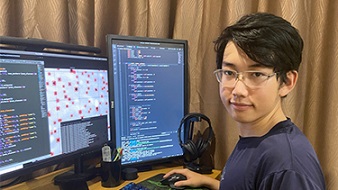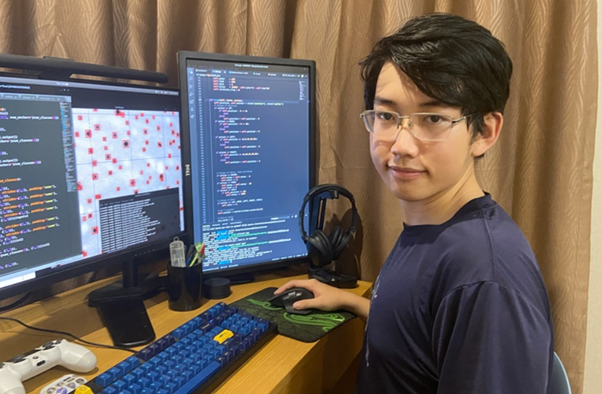Data science undergraduate’s first published research comes from years of passion for computing

Duke Kunshan student Eric Qu is just two years into his degree but has already published a paper in a major academic journal as the first author.

Data science undergraduate Eric Qu
The data science undergraduate has been engaged in a project looking at the properties of polymer nanocomposite, the results of which were published in the American chemistry society journal Macromolecule recently. Polymer nanocomposites are organic materials given additional properties such as greater strength or resistance to corrosion, by adding inorganic nanoparticles. Shedding light on the properties of these hybrid materials could allow for these special qualities to be enhanced.
“This project provides a helpful tool, which could help advance research into these materials. I felt like I was really involved in something important,” said Qu, who was first author on the paper.
The research project was the culmination of six months of hard work, involving Qu, Kai Zhang, assistant professor of chemistry at Duke Kunshan, Sanat Kumar, a professor in the Department of Chemical Engineering at Columbia University in New York and Andrew Jimenez, who was a research assistant working under Kumar and is now at the University of Washington.
It meant “long hours at the computer,” said Qu, often working from his university dorm room due to Covid-19 restrictions and communicating with colleagues through online video calls.
The project set out to quantify the number and spacing of nanoparticles in a polymer nanocomposite, organic materials given additional properties by adding inorganic particles, which are used in the manufacture of medical devices and in engineering, among other areas. Understanding the distribution of nanoparticles in them better could shed light on why they possess special properties, opening the door to making improvements.
Currently, information on nanoparticle distribution is obtained by looking at transmission electron microscopy (TEM) images, where a beam of electrons is transmitted through the material to form an image, and using scattering probes, such as small-angle X-rays. Traditional methods use handcrafted algorithms to locate the positions of nanoparticles, which is inaccurate and unable to detect chains and clusters of nanoparticles.
Qu and his colleagues improved on the ability to quantify the distribution of nanoparticles by developing an artificial intelligence model that can analyse TEM images of polymer nanocomposite materials giving more accurate location information.
For Qu, the eureka moment in the project came when the AI model learned to recognize the first few TEM images. It was “really exciting” to see the model, which he had worked so hard to develop, actually working, he said.
That was not the first moment of joy inspired by computing in Qu’s life. Originally from a small town in Shandong province on the northeast coast of China, five hours south of Beijing by train, his excitement about computing began aged just two, when his father came home with a present – his first computer. It was a moment that would start the journey towards studying at DKU, as his father’s gift became both a tool to learning English and an object that inspired a passion for computing.
Qu’s interest in computing extended beyond gaming, and by 12 he had joined a computer club at school and made his first two programs, a calculator and a simple script game.
At high school he became a competitor in a national programming competition called the Olympics of Informatics, which involved undertaking a series of contests, ending up among the top echelon of competitors. That experience broadened his horizons and combined with his love of computing led him towards a degree in data science at Duke Kunshan, which harnessed his passion for programming and applied it to important scientific research.
“Data science is a highly interdisciplinary major,” said Qu. “It is interesting to work with and learn from people in other disciplines. The concept of artificial intelligence is also intriguing. I really enjoy doing research in data science.”
Despite the research achievement, Qu is not resting on his laurels. He’s already engaged in several new interdisciplinary projects with Professor Zhang. They include detecting oriented microcrystals in TEM images and calculating the number sticky hard spheres in rigid packing.
He’s also looking forward to spending a semester at Duke University in Durham, North Carolina, next year, and he’s considering the future beyond university, which include potentially continuing with research and a PhD, or going into industry.